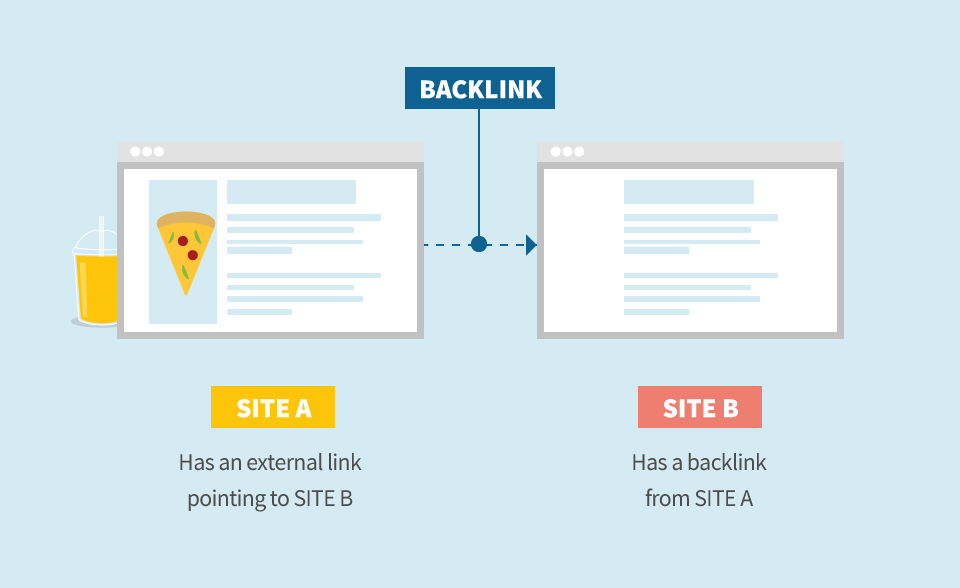Backlinks in SEO
In the ever-evolving realm of digital marketing, search engine optimization (SEO) is a critical component, and understanding backlinks in SEO is pivotal to achieving online success. What are backlinks, and why do they matter? In this comprehensive guide, we will unravel the mysteries surrounding backlinks, exploring their types, significance, and strategies to optimize their impact on your SEO efforts.
Understanding Backlinks
What are Backlinks?
Backlinks, also known as inbound or incoming links, are links from one website to another. They serve as pathways that guide users from one web page to another, and they play a vital role in SEO. In essence, backlinks act as endorsements from one website to another. When a reputable website links to your content, it indicates to search engines that your content is valuable and credible.
Types of Backlinks
Not all backlinks are created equal. They can be categorized into two primary types:
- DoFollow Backlinks: These are the standard backlinks that pass “link juice” from the referring website to the linked website. They are crucial for SEO and contribute to higher search engine rankings.
- NoFollow Backlinks: These backlinks include a special HTML tag, “rel=nofollow,” which informs search engines not to follow or pass any authority to the linked website. While they may not have the same direct SEO impact as DoFollow links, they are essential for diversifying your backlink profile and reaching a wider audience.
Why Backlinks Matter
Backlinks matter for several reasons:
- Search Engine Rankings: Backlinks are a core element of search engine algorithms. Websites with a robust backlink profile tend to rank higher in search results.
- Credibility and Authority: Backlinks from authoritative websites signal to search engines and users that your content is trustworthy and valuable.
- Increased Organic Traffic: Backlinks from relevant websites can drive targeted traffic to your site, increasing your potential for conversions.
Backlink Fundamentals
Now that we’ve established the basics, it’s time to explore some fundamental aspects of backlinks that are crucial for your SEO endeavors.
Link Quality vs. Quantity
The quality of backlinks significantly outweighs the quantity. While having numerous backlinks may seem beneficial, the reality is that high-quality backlinks have a more substantial impact on your search engine rankings. A single backlink from a reputable, authoritative website can carry more weight than multiple links from less credible sources.
When considering backlink quality, think about the relevance of the linking website to your content. Is it an industry leader or a well-regarded source? Such attributes can greatly enhance the credibility of the backlink.
Link Attributes (DoFollow vs. NoFollow)
Link attributes determine how search engines perceive and handle backlinks. The most common attributes are “DoFollow” and “NoFollow.”
- DoFollow Backlinks: These links allow link juice to pass from the referring website to your site. As mentioned earlier, they have a direct positive impact on your SEO by boosting your site’s authority and rankings.
- NoFollow Backlinks: NoFollow links include a specific HTML tag, “rel=nofollow,” which instructs search engines not to follow the link or pass any authority to the linked website. While these links don’t offer the same SEO boost as DoFollow links, they still have value in diversifying your backlink profile.
Link Building vs. Natural Backlinks
Backlinks can be acquired through two primary methods: link building and natural backlinks.
- Link Building: This involves a proactive approach to acquiring backlinks. It includes strategies such as guest posting, content outreach, and influencer collaborations. Link building allows you to have more control over the backlinks you acquire.
- Natural Backlinks: These backlinks occur organically when other websites link to your content because they find it valuable. Natural backlinks are a testament to the quality and relevance of your content.
While both link-building and natural backlinks have their merits, a balanced approach that incorporates both can yield the best results for your SEO strategy.
The Significance of Backlinks in SEO
Now that we’ve laid the groundwork by understanding what backlinks are and their fundamental aspects, it’s time to dive deeper into why backlinks are so crucial for SEO.
Backlinks and Search Engine Rankings
At the heart of SEO lies the desire to improve your website’s visibility in search engine results. Backlinks play a pivotal role in achieving this goal. Search engines like Google use complex algorithms to assess and rank websites, and one of the significant factors they consider is the quality and quantity of backlinks pointing to a site.
Websites with a robust backlink profile tend to enjoy higher search engine rankings. When authoritative websites link to your content, it’s seen as a vote of confidence, signaling to search engines that your content is trustworthy and relevant. As a result, your website is more likely to appear on the coveted first page of search results.
Backlinks and Authority Building
Cultivating online authority is a fundamental aspect of digital marketing. Backlinks are instrumental in this pursuit. When reputable websites link to your content, they vouch for your credibility and expertise in a particular field.
Imagine your website as a library, and each backlink as a reference from an expert in the field. The more references you have, the more authoritative and credible your library becomes. This authority extends not only to the specific topic of the backlink but also to your website as a whole.
Backlinks and Organic Traffic
One of the primary objectives of any digital marketing strategy is to attract relevant and organic traffic. Backlinks play a critical role in achieving this. When your content is linked to other websites in the same niche or industry, it acts as a beacon for users interested in that topic.
As users click on these backlinks and navigate to your website, they represent highly targeted organic traffic. This audience is more likely to engage with your content, stay longer on your site, and potentially convert into leads or customers.
Key Backlink Strategies
To harness the full power of backlinks for your SEO efforts, you need to implement key strategies that focus on creating, acquiring, and managing these invaluable links.
Creating High-Quality Backlinks
Guest Posting
Guest posting involves writing and publishing content on other websites within your niche or industry. In exchange for your contribution, you can include backlinks to your site within the content or author bio. This not only exposes your content to a new audience but also allows you to acquire relevant backlinks from authoritative sources.
Content Outreach
Content outreach is the proactive approach of reaching out to website owners, bloggers, and influencers in your field to request backlinks to your content. It often involves showcasing the value and relevance of your content to their audience. Successful content outreach can lead to high-quality backlinks from respected sources.
Infographics and Visual Content
Infographics and visual content have a unique ability to attract backlinks. These visually engaging assets are highly shareable and can be used as linkable resources. Websites often link to infographics and visuals as references in their content, providing you with valuable backlinks.
Blogger and Influencer Outreach
Collaborating with bloggers and influencers is a potent strategy for acquiring backlinks. When influential figures in your industry reference or promote your content, it not only boosts your website’s credibility but can also drive significant traffic and lead to more backlinks.
Monitoring and Managing Backlinks
Backlink Analysis Tools
To effectively manage your backlink profile, you’ll need to employ backlink analysis tools. These tools provide insights into your existing backlinks, including their quality, source, and anchor text. Tools like Ahrefs, Moz, and SEMrush can help you evaluate your backlink health and identify areas for improvement.
Disavowing Toxic Backlinks
Not all backlinks are beneficial. Toxic backlinks from low-quality or spammy websites can harm your SEO efforts. The disavow tool in Google Search Console allows you to request that Google ignore these toxic backlinks, helping you maintain a healthy backlink profile.
Regular Backlink Audits
Performing regular backlink audits is essential to ensure your backlink profile remains clean and effective. By identifying and removing low-quality or irrelevant backlinks, you can maintain a strong and authoritative online presence.
By incorporating these key backlink strategies into your digital marketing efforts, you can enhance your website’s authority, drive organic traffic, and improve your search engine rankings. The journey to SEO success is an ongoing one, and optimizing your backlink strategy is an integral part of that journey.
Measuring Backlink Success
Once you’ve implemented backlink strategies, it’s essential to measure their impact and determine whether your efforts are yielding positive results. This section will explore key metrics and methods for evaluating the success of your backlink strategy.
Key Metrics for Backlinks
Several key metrics can help you gauge the effectiveness of your backlinks:
- Organic Traffic: Observe the increase in organic traffic to your website. Quality backlinks should lead to a higher volume of organic visitors.
- Keyword Rankings: Track the improvement of your website’s rankings for target keywords. As your backlink profile strengthens, you should see progress in keyword rankings.
- Conversion Rates: Analyze whether the increase in traffic from backlinks results in higher conversion rates, such as leads or sales. A successful backlink strategy should boost these conversion rates.
- Bounce Rate: Examine the bounce rate of visitors arriving via backlinks. A lower bounce rate indicates that visitors find your content relevant and engaging.
- Domain Authority: Keep an eye on your website’s domain authority, which is influenced by the quality of backlinks. As your domain authority increases, so does your overall online authority.
Using Analytics to Evaluate Backlink Performance
Google Analytics and other web analytics tools are invaluable for evaluating backlink performance. Here’s how to do it:
- Behavior Flow: Analyze the behavior flow of visitors from backlinks. Are they navigating through your site and engaging with content?
- Conversion Tracking: Set up conversion tracking to measure the number of leads or sales generated by visitors from specific backlinks.
- Referral Traffic: Identify the websites that send the most referral traffic. This data can help you identify high-performing backlinks.
- Bounce Rates: Compare bounce rates from different backlink sources. Low bounce rates indicate the quality and relevance of the linked content.
- Acquisition Reports: Use acquisition reports to track the sources of traffic. This allows you to see which backlinks are delivering the most visitors.
Improving Your Backlink Strategy
Continuous improvement is vital in SEO. Regularly assess your backlink strategy and adapt it based on performance data. Remove or disavow toxic backlinks and focus on acquiring high-quality ones. Collaboration with influencers and authoritative websites in your niche can significantly improve your backlink profile.
Backlink Challenges and Solutions
While backlinks are instrumental in SEO success, they also present challenges that digital marketers must overcome. In this section, we’ll explore common challenges and provide effective solutions to ensure your backlink strategy remains robust.
Backlink Quality vs. Quantity Dilemma
Challenge: Striking the right balance between backlink quality and quantity is a common challenge. Focusing solely on quantity can lead to low-quality backlinks that harm your SEO efforts, while focusing only on quality may limit your outreach.
Solution: Embrace a balanced approach. Prioritize high-quality backlinks, but also seek opportunities to acquire a reasonable quantity of relevant links. Quality should always be the primary focus, but quantity can help diversify your backlink profile.
Avoiding Toxic Backlinks
Challenge: Toxic backlinks from spammy or low-quality websites can damage your website’s reputation and search engine rankings. Identifying and disavowing these backlinks is crucial but can be challenging.
Solution: Regularly conduct backlink audits using tools like Google Search Console or third-party SEO tools to identify toxic backlinks. Once identified, use Google’s disavow tool to request that these links be ignored. Vigilance is key to keeping your backlink profile clean.
Staying Updated with Algorithm Changes
Challenge: Search engine algorithms, particularly Google’s, undergo frequent updates. These changes can impact the effectiveness of your backlink strategy, making it essential to stay updated.
Solution: Stay informed about algorithm updates through reputable SEO news sources. Attend industry events and webinars to gain insights into algorithm changes and best practices. Adapt your backlink strategy accordingly to align with the evolving algorithms.
Dealing with Negative SEO
Challenge: Negative SEO refers to malicious attempts to harm a website’s SEO, often through the creation of toxic backlinks. Protecting your website from such attacks can be challenging.
Solution: Regularly monitor your backlink profile for suspicious activity. If you detect a surge in toxic backlinks, disavow them immediately. Strengthen your website’s security measures to prevent negative SEO attacks.
By addressing these common challenges and applying the provided solutions, you can navigate the dynamic landscape of backlinks in SEO more effectively. Your ability to adapt and proactively manage your backlink strategy will be instrumental in maintaining a strong online presence and search engine rankings.

FAQs
What are backlinks and why are they important in SEO?
Answer: Backlinks, also known as inbound links or incoming links, are links from one website to another. They are essential in SEO because they act as endorsements, indicating that your content is valuable and credible. Search engines use backlinks as a factor in determining your website’s authority and search engine rankings.
How can I differentiate between high-quality and low-quality backlinks?
Answer: High-quality backlinks come from authoritative, reputable websites within your niche. They are relevant and contribute positively to your SEO. Low-quality backlinks, on the other hand, often originate from spammy or irrelevant sources and can harm your SEO efforts.
What is the significance of anchor text in backlinks?
Answer: Anchor text is the clickable text in a hyperlink. It provides context about the linked page’s content. Using descriptive and relevant anchor text is vital, as it helps search engines understand the content of the linked page and improves SEO.
Can I build backlinks too fast?
Answer: Yes, building backlinks too rapidly can raise red flags with search engines and lead to penalization. It’s important to focus on a natural and gradual backlink acquisition process to maintain SEO integrity.
How do I disavow toxic backlinks?
Answer: To disavow toxic backlinks, you can use Google’s Disavow Tool within Google Search Console. You’ll create a disavow file and submit it to Google, requesting that the search engine ignore those specific backlinks.
Do social media links count as backlinks?
Answer: Social media links are not traditional backlinks, but they are valuable for driving traffic and increasing your online presence. While they don’t directly impact search engine rankings, they can indirectly contribute to SEO success.
Can internal links be considered backlinks?
Answer: Internal links connect different pages within your website. They are not considered backlinks in the traditional sense, but they are important for user experience and can help distribute link authority throughout your site.
How do I track the performance of my backlinks?
Answer: You can track backlink performance using web analytics tools like Google Analytics. Monitor organic traffic, keyword rankings, and referral traffic to gauge the effectiveness of your backlinks.
What is the impact of backlinks on local SEO?
Answer: Backlinks can significantly impact local SEO by increasing the authority and credibility of your website within your local area. Local backlinks from relevant sources can improve your local search engine rankings.
How can I earn natural backlinks?
Answer: Creating high-quality, shareable content, promoting it through social media and outreach, and providing value to your audience are all effective ways to naturally earn backlinks from other websites.
In the realm of digital marketing, understanding and harnessing the power of backlinks is a journey that can significantly impact your website’s visibility, authority, and success. We’ve embarked on this journey, starting with the basics of what backlinks are and why they matter. From there, we delved into the fundamental aspects of backlinks, the crucial balance between quality and quantity, and the essential distinction between DoFollow and NoFollow links.
As we continued our exploration, we unveiled the significance of backlinks in SEO, learning how they influence search engine rankings, authority building, and the generation of organic traffic. The strategies for creating high-quality backlinks and effectively managing your backlink profile equipped you with actionable insights for enhancing your SEO endeavors.
Measuring backlink success and addressing common challenges allowed you to fine-tune your approach and adapt to the ever-evolving digital landscape. We discussed the importance of staying updated with algorithm changes and how to defend your website against negative SEO tactics.
The FAQs provided in-depth answers to the most pressing questions about backlinks in SEO. These insights serve as a valuable resource for navigating the complexities of backlink strategies.
In closing, it’s important to remember that SEO is a dynamic and multifaceted field. Backlinks are a pivotal element in this journey, but they are most effective when combined with other best practices, such as high-quality content, technical SEO, and user experience optimization.
As you embark on your digital marketing voyage, keep this comprehensive guide as your compass. Let it serve as a reference for understanding, implementing, and optimizing backlinks in SEO. Armed with this knowledge, you are better prepared to achieve higher search engine rankings, increased organic traffic, and a stronger online presence.




